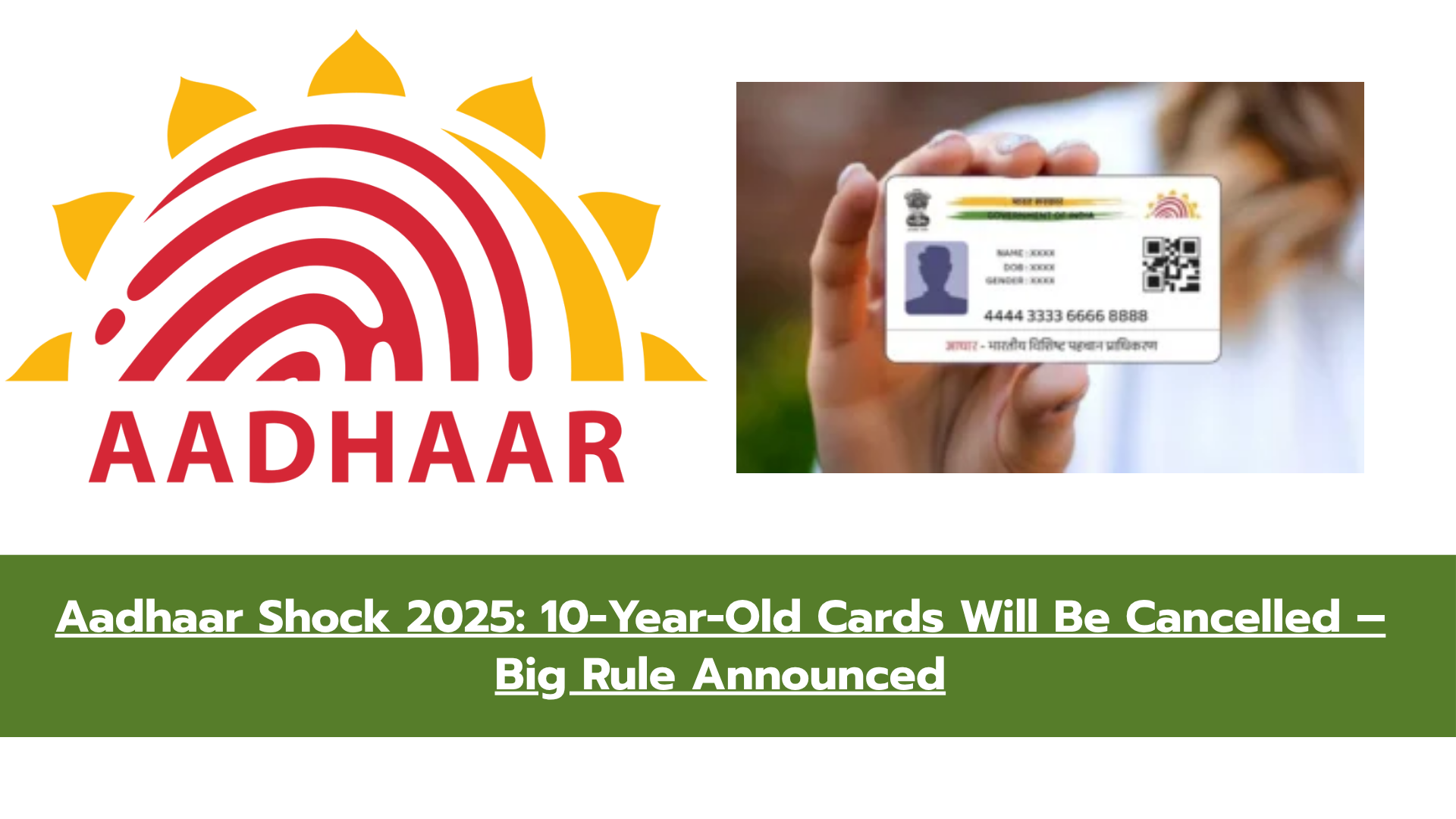The Unique Identification Authority of India (UIDAI) has brought a major change in Aadhaar rules for 2025. All Aadhaar cards that are more than 10 years old will be deactivated if they are not revalidated. This new rule is being introduced to keep Aadhaar data accurate, secure, and updated for over 1.38 billion Indian citizens.
From January 1, 2026, Aadhaar cards issued before January 1, 2016, will stop working if the holder has not updated their biometric or demographic information. This means people may face issues in banking, SIM card usage, government benefits, and tax filing if they don’t update their Aadhaar in time.
Why UIDAI Is Deactivating Old Aadhaar Cards
The Aadhaar database was created years ago, and in that time, many people’s biometric and personal details may have changed. Fingerprints, facial features, addresses, and contact details often change over time.
To avoid misuse, identity theft, and outdated records, UIDAI has decided to make revalidation compulsory every 10 years. This ensures that the Aadhaar system remains reliable and matches global best practices, just like renewing a passport or driving licence.
The main goals behind this policy are:
- Prevent identity fraud and duplicate entries
- Refresh old biometric and demographic information
- Make Aadhaar-linked services more secure
- Follow updated data protection rules under India’s Digital Personal Data Protection Act, 2023
Who Will Be Affected by This Rule
Anyone who received their Aadhaar before 31st December 2015 will have to complete the revalidation process. This includes:
- People enrolled during the early Aadhaar years (2010–2015)
- Those who haven’t updated their details for 10+ years
- Citizens using Aadhaar without linking or verification
UIDAI estimates that nearly 32 crore Aadhaar cards fall under this category. If these are not updated by the deadline, they will be temporarily blocked.
Step-by-Step Process to Revalidate Aadhaar
UIDAI has made the revalidation process simple and accessible. You can update your details through biometric, demographic, or both methods.
Step 1: Visit the Nearest Enrolment Centre
Go to a Permanent Enrolment Centre (PEC). Carry original documents for proof of identity, address, and date of birth.
Step 2: Biometric Update
Your fingerprints, iris scan, and facial recognition will be captured again to reflect current data.
Step 3: Update Personal Details
If your name, address, mobile number, or email has changed, update it during the visit.
Step 4: Get Confirmation
You will receive a Transaction Reference Number (TRN). The updated Aadhaar will be available for download or sent to your address within 15–20 days.
For senior citizens and differently-abled individuals, video-based biometric revalidation is being tested to make the process easier.
Different Revalidation Options
| Revalidation Type | Who Can Use It | Documents Required | Timeframe |
|---|---|---|---|
| Biometric Update | All Aadhaar holders with outdated biometrics | Aadhaar, original ID proof | 15–20 days |
| Demographic Update | People with changed name/address/contact | Aadhaar, supporting documents | 10–15 days |
| Full Revalidation | Cards older than 10 years | Aadhaar, ID & address proof | 20–25 days |
| Online Update (Limited) | Mobile/email updates only | Aadhaar number, OTP | Immediate |
Note: Biometric updates can only be done offline at an enrolment centre.
Impact of Not Updating Aadhaar
If you don’t revalidate your Aadhaar by the deadline, it will be blocked temporarily. This will affect many important services, such as:
- Banking: No account operations, UPI linking, or loan applications
- Mobile Connections: Linked SIM cards may be deactivated
- Government Benefits: PM-KISAN, LPG subsidy, pensions, and DBT schemes will stop
- Tax Filing: PAN-Aadhaar linking may fail, blocking ITR submission
- Travel: Aadhaar-based verification at airports and railways will not work
UIDAI will give a 90-day grace period after blocking, during which citizens can still update without penalties. However, services will stay suspended until Aadhaar is revalidated.
Special Help for Vulnerable Groups
UIDAI has made special arrangements to ensure everyone can update easily:
- Senior Citizens: Mobile enrolment vans will visit homes and community centres.
- Differently-Abled Individuals: Special lanes and support at centres.
- Rural Areas: Temporary Aadhaar camps will be set up in remote villages.
- Children: Aadhaar must be updated at ages 5 and 15. Cards issued before 2015 will need revalidation if affected.
How to Check If Your Aadhaar Needs Revalidation
To find out if your Aadhaar is at risk:
- Visit the UIDAI website.
- Check the enrolment date and last update history.
- If it’s older than 10 years and hasn’t been updated, book a revalidation slot as soon as possible.
Conclusion
The 2025 Aadhaar update is one of the biggest changes since Aadhaar was introduced. By making 10-year revalidation mandatory, UIDAI is focusing on security, data accuracy, and better service delivery. Citizens should act early to avoid disruptions in banking, government schemes, or telecom services. Updating your Aadhaar is a simple step that ensures smooth access to essential services in the years ahead.
FAQs
Why is Aadhaar revalidation required after 10 years?
It is required to keep biometric and demographic details up to date and prevent fraud.
What happens if I don’t update my Aadhaar?
Your Aadhaar will be temporarily blocked, affecting banking, telecom, and government services.
Can I update Aadhaar online?
Only demographic details like mobile number or email can be updated online. Biometric updates must be done at a centre.
Is there a deadline for the update?
Yes. All Aadhaar cards issued before January 1, 2016, must be updated by January 1, 2026.
Is there any fee for the update?
A nominal fee may apply at enrolment centres, depending on the type of update.

